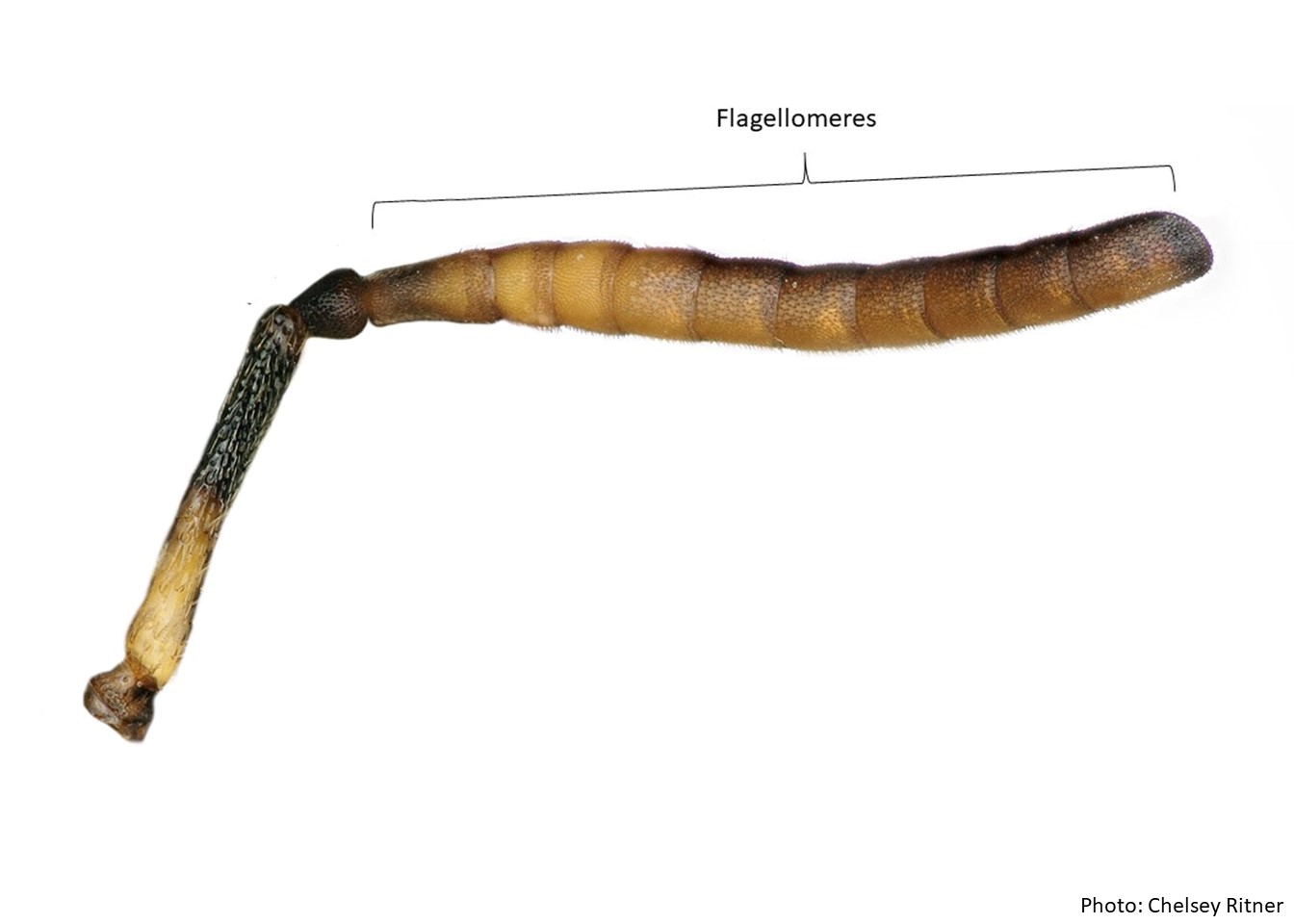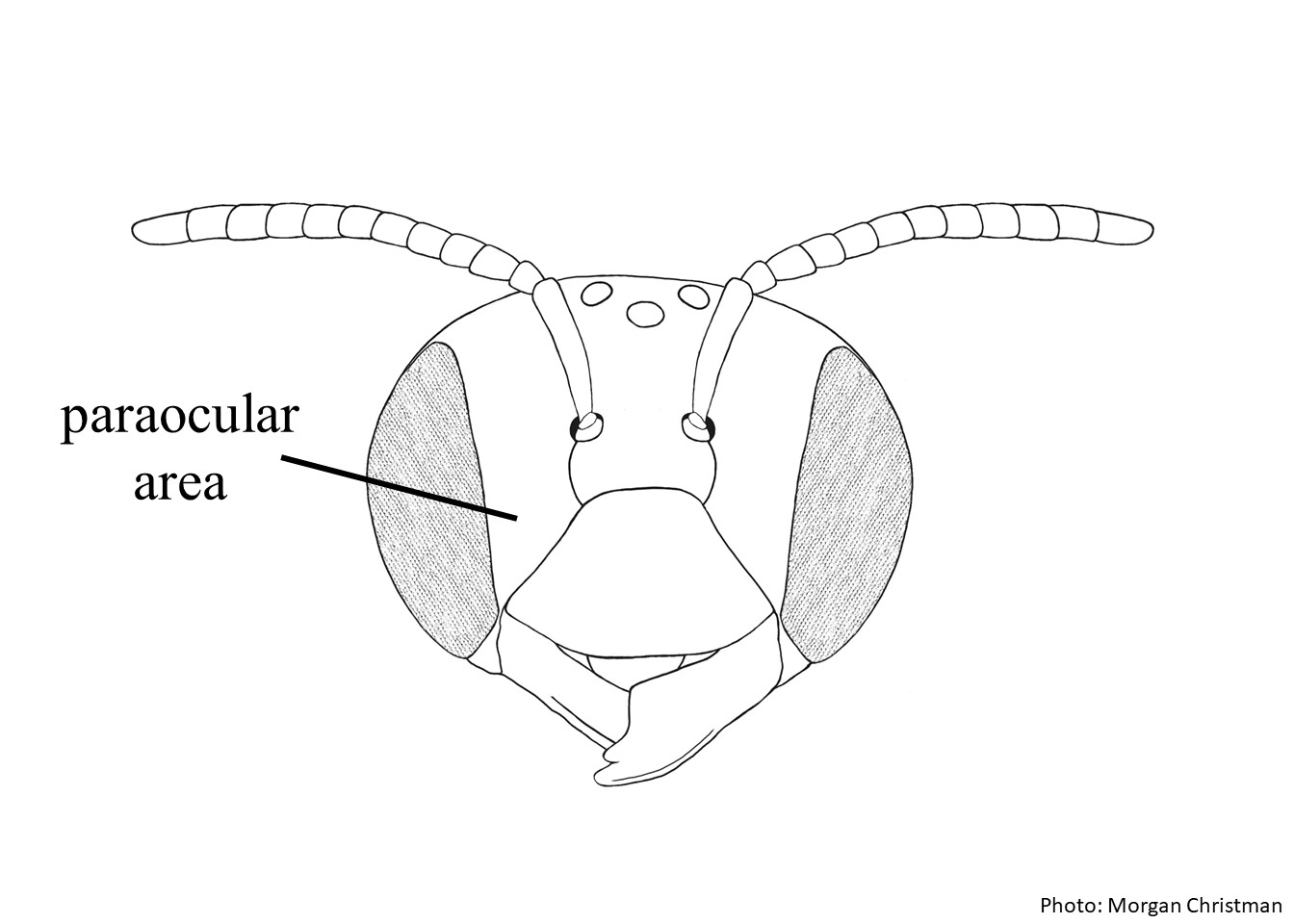Family: Megachilidae
Subfamily: Megachilinae
Tribe: Anthidiini
Genus: Anthidium Fabricius, 1804
Subgenus: A. (Anthidium) Fabricius, 1804
Species: Anthidium palmarum Cockerell, 1904
Common name: none
Anthidium (Anthidium) palmarum are black with light reddish-brown to dark brown antennal flagellumflagellum:
any segment of the antenna past the scape and pedicel and yellow maculations (Gonzalez and Griswold 2013Gonzalez and Griswold 2013:
and yellow maculations (Gonzalez and Griswold 2013Gonzalez and Griswold 2013:
Gonzalez, V.H. and T.L. Griswold. 2013. Wool carder bees of the genus Anthidium in the Western Hemisphere (Hymenoptera: Megachilidae): diversity, host plant associations, phylogeny, and biogeography. Zoological Journal 168: 221ndash;425.). Females have white pubescencepubescence:
short, fine hair
, except for ferruginousferruginous:
rust-colored
hairs found on the vertexvertex:
the area between the ocelli and the back of the head, pronotal lobepronotal lobe:
a part of the pronotum located dorsally on the posterior margin of the pronotum and overlaps the anterior thoracic spiracle, scutumscutum:
the large segment on top of the thorax located between the wings and behind the head
, axillaaxilla:
the triangular or rounded point on the thorax where thoracic muscles meet the forewing of an insect, scutellumscutellum:
shield shaped plate behind scutum, inner tarsitarsi:
the group of segments at the end of the leg following the tibia
, and center of S6S6:
the plates on the underside of the abdomen, often abbreviated when referring to a specific segment to S1, S2, S3, S4, S5, S6, S7, or S8
 . Females range in body length from 7.2–9.4 mm (Gonzalez and Griswold 2013Gonzalez and Griswold 2013:
. Females range in body length from 7.2–9.4 mm (Gonzalez and Griswold 2013Gonzalez and Griswold 2013:
Gonzalez, V.H. and T.L. Griswold. 2013. Wool carder bees of the genus Anthidium in the Western Hemisphere (Hymenoptera: Megachilidae): diversity, host plant associations, phylogeny, and biogeography. Zoological Journal 168: 221ndash;425.). Male tergaterga:
the segments on the top side of the abdomen, often abbreviated when referring to a specific segment to T1, T2, T3, T4, T5, T6, or T7 have finer punctures and broader impunctateimpunctate:
have finer punctures and broader impunctateimpunctate:
marked with punctures or pits
apicalapical:
near or at the apex or end of any structure
margins than those in females. Males range in body length from 8.8–13.1 mm (Gonzalez and Griswold 2013Gonzalez and Griswold 2013:
Gonzalez, V.H. and T.L. Griswold. 2013. Wool carder bees of the genus Anthidium in the Western Hemisphere (Hymenoptera: Megachilidae): diversity, host plant associations, phylogeny, and biogeography. Zoological Journal 168: 221ndash;425.).
(modified from Gonzalez and Griswold 2013Gonzalez and Griswold 2013:
Gonzalez, V.H. and T.L. Griswold. 2013. Wool carder bees of the genus Anthidium in the Western Hemisphere (Hymenoptera: Megachilidae): diversity, host plant associations, phylogeny, and biogeography. Zoological Journal 168: 221ndash;425.)
 lacks basalbasal:
lacks basalbasal: lacks distinct laterallateral:
lacks distinct laterallateral: preapical projections are larger than that in females.
preapical projections are larger than that in females. laterallateral:
laterallateral: median spine.
median spine. laterallateral:
laterallateral: median apicalapical:
median apicalapical: apicalapical:
apicalapical: with rounded laterallateral:
with rounded laterallateral: is pointed apicallyapically:
is pointed apicallyapically: is weakly bifidbifid:
is weakly bifidbifid:Female A. palmarum can be distinguished from all North American Anthidium, aside from A. schwarzi, by the combination of the rounded sublateral lobes of T6T6:
the segments on the top side of the abdomen, often abbreviated when referring to a specific segment to T1, T2, T3, T4, T5, T6, or T7 and dense tomentumtomentum:
and dense tomentumtomentum:
a form of pubescence composed of short matted, woolly hair
on the basitarsibasitarsi:
the segment of the tarsus that is the nearest to the body of the bee, usually the largest of all the tarsal segments (Gonzalez and Griswold 2013Gonzalez and Griswold 2013:
Gonzalez, V.H. and T.L. Griswold. 2013. Wool carder bees of the genus Anthidium in the Western Hemisphere (Hymenoptera: Megachilidae): diversity, host plant associations, phylogeny, and biogeography. Zoological Journal 168: 221ndash;425.). Female A. palmarum can be differentiated from A. schwarziby the lack of a distinct laterallateral:
relating, pertaining, or attached to the side
spine on T6T6:
the segments on the top side of the abdomen, often abbreviated when referring to a specific segment to T1, T2, T3, T4, T5, T6, or T7 , and the prominent yellow markings on the clypeusclypeus:
, and the prominent yellow markings on the clypeusclypeus:
a section of the face below the antennae, demarcated by the epistomal sutures, paraocularparaocular:
the area extending along the sides of the face parallel to the eye
 areas, and mandibles (Gonzalez and Griswold 2013Gonzalez and Griswold 2013:
areas, and mandibles (Gonzalez and Griswold 2013Gonzalez and Griswold 2013:
Gonzalez, V.H. and T.L. Griswold. 2013. Wool carder bees of the genus Anthidium in the Western Hemisphere (Hymenoptera: Megachilidae): diversity, host plant associations, phylogeny, and biogeography. Zoological Journal 168: 221ndash;425.). Male A. palmarum can be differentiated from A. schwarziby the narrow laterallateral:
relating, pertaining, or attached to the side
lobe on T7T7:
the segments on the top side of the abdomen, often abbreviated when referring to a specific segment to T1, T2, T3, T4, T5, T6, or T7 , and S6S6:
, and S6S6:
the plates on the underside of the abdomen, often abbreviated when referring to a specific segment to S1, S2, S3, S4, S5, S6, S7, or S8
 with a low laterallateral:
with a low laterallateral:
relating, pertaining, or attached to the side
lobe and a shorter median lobe that is weakly emarginated.
Anthidium palmarum adults have been recorded in flight from February to early July, with peak activity occurring from April to May (Gonzalez and Griswold 2013Gonzalez and Griswold 2013:
Gonzalez, V.H. and T.L. Griswold. 2013. Wool carder bees of the genus Anthidium in the Western Hemisphere (Hymenoptera: Megachilidae): diversity, host plant associations, phylogeny, and biogeography. Zoological Journal 168: 221ndash;425.).
Anthidium palmarum is a generalist that has been observed visiting a variety of species within Alliaceae, Asteraceae, Boraginaceae, Brassicaceae, Lamiaceae, Malvaceae, Onagraceae, Polygonaceae, Plantaginaceae, and Solanaceae (Gonzalez and Griswold 2013Gonzalez and Griswold 2013:
Gonzalez, V.H. and T.L. Griswold. 2013. Wool carder bees of the genus Anthidium in the Western Hemisphere (Hymenoptera: Megachilidae): diversity, host plant associations, phylogeny, and biogeography. Zoological Journal 168: 221ndash;425.).
Anthidium palmarum nests are constructed in burrows in dead flower stems of Hesperoyucca whipplei (Agavaceae) (Hurd 1979Hurd 1979:
Hurd Jr., P.D. 1979. Superfamily Apoidea: In: Krombein K.V, J.P.D. Hurd, D.R. Smith, B.D. Burks, eds Catalog of Hymenoptera in America North of Mexico. Vol. 2. Washington, DC: Smithsonian Institution Press: 1741ndash;2209.). Males actively patrol the areas around the female’s preferred host plants, and will participate in confrontations when needed. Confrontations occur when the male needs to defend their territory from other territorial males, when they need to protect their territory from other insects, and when they participate in sexual encounters with females (Wainwright 1978Wainwright 1978:
Wainwright, C.M. 1978. Hymenopteran territoriality and its influence on the pollination ecology of Lupinus arizonicus. The Southwestern Naturalist 23: 605ndash;616.).
Anthidium palmarum occur in the U.S. throughout southern California, Arizona, New Mexico, western Texas, southern Nevada, and southern Utah. In Mexico, they can be found in Baja California and Sonora. They are predominantly found in the Mojave, Sonoran, Baja California, and Chihuahuan Deserts. However, they also range north into southern San Joaquin Valley, southern Great Basin, Arizona mountain forests, and Colorado Plateau shrublands (Gonzalez and Griswold 2013Gonzalez and Griswold 2013:
Gonzalez, V.H. and T.L. Griswold. 2013. Wool carder bees of the genus Anthidium in the Western Hemisphere (Hymenoptera: Megachilidae): diversity, host plant associations, phylogeny, and biogeography. Zoological Journal 168: 221ndash;425.).
Distribution map generated by Discover Life -- click on map for details, credits, and terms of use.
Gonzalez, V.H. and T.L. Griswold. 2013. Wool carder bees of the genus Anthidium in the Western Hemisphere (Hymenoptera: Megachilidae): diversity, host plant associations, phylogeny, and biogeography. Zoological Journal of the Linnean Society 168: 221-425.
Hurd Jr., P.D. 1979. Superfamily Apoidea: In: Krombein K.V, J.P.D. Hurd, D.R. Smith, B.D. Burks, eds Catalog of Hymenoptera in America North of Mexico. Vol. 2. Washington, DC: Smithsonian Institution Press: 1741-2209.
Wainwright, C.M. 1978. Hymenopteran territoriality and its influence on the pollination ecology of Lupinus arizonicus. The Southwestern Naturalist 23: 605-616.